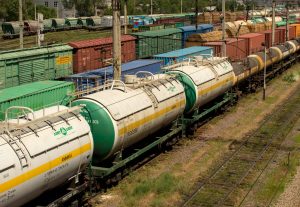The U.S. Trade Representative (USTR) Kathleen Tai visited Kazakhstan and Uzbekistan in mid-June, the first time a USTR has ever visited the Central Asian region. There, the U.S. co-chaired a U.S.-Central Asia Trade and Investment Framework Agreement (TIFA) Council meeting in Astana. The goal? Support the Trans-Caspian International Transport Route (TITR), better known as the Middle Corridor, which aims to connect the region with the West, bypassing Russia via a route across the Caspian and through the Caucasus. In doing so, the region hopes to boost Western investment for more prosperity but also to balance off China and Russia.
Making the Middle Corridor efficient remains a challenge, and the World Bank has identified ten actions that can triple trade along the corridor by 2030. Winnie Wang, program leader for Europe and Central Asia at the World Bank, discussed these suggestions at the recent Trans Caspian Forum in Washington, D.C. Specific proposals aimed at the Central Asian nodes and arteries of the Corridor include bypasses to reduce congestion in urban centers, a new railway to connect Kazakhstan and Uzbekistan, and acquiring modern equipment to increase berth capacity at Kazakhstan’s Aktau port.
The World Bank and others also strive to synchronize regional institutions and improve border management by digitizing systems to minimize wait times as cargo clears customs services. These improvements will have the added benefit of preventing extra-regional powers from pitting local actors against one another. The World Bank views the corridor as the “backbone for Central Asian and South Caucasus economic development.”
Greater cooperation among Middle Corridor members is essential, but it will become more challenging as other countries begin projects to smother the corridor. After much cajoling by Beijing and failures by Western actors to effectively engage with the region, the much-delayed China-Kyrgyzstan-Uzbekistan railway is on track to be built. This new route will compete with the Middle Corridor, directing trade flows away from the West and toward China.
Several regional mechanisms have overlapping membership across Central Asia and the Caucasus, including the Organization for Turkic States or the Conference on Interaction and Confidence Building Measures in Asia (CICA), headquartered in Astana. Alas, achieving intra-regional cooperation and integration between Central Asia and the South Caucasus remains challenging, given border disputes, occasional disagreements between Azerbaijan and Turkmenistan, and sometimes contradictory objectives. Still, Central Asia must maintain its strategic autonomy.
Looking to the future, a broader regional mechanism in charge of the corridor is needed to take the route to the next level, particularly if other countries join the effort (such as Uzbekistan or Armenia). At the second Caspian Connectivity Conference in London, organized on June 11, Magzhan Ilyassov, ambassador of Kazakhstan to the U.K., declared: “We have to turn it into a viable route that exists by itself… For now, our ambition when I say ‘ours’ is not only [Kazakhstan] but also all of the countries present here.”
While Kazakhstan certainly isn’t the only country with a vested interest in the Middle Corridor and Western cooperation, it does seem to be doing the most to realize it – more than the West itself. Kazakhstan’s long-standing multi-vector foreign policy requires Western investment. Kazakhstan’s President Kassym-Jomart Tokayev, a former foreign minister, has repeatedly called for more Western investment to realize the Middle Corridor fully.
What should be an easy sell remains frustratingly unrealized. As the war in Ukraine continues, Europe strongly supports the corridor. Its realization would allow a route to Central Asian commodities and Chinese goods, bypassing Russia.
On June 12, a new coordination platform for the Middle Corridor was launched in Astana to “turn the corridor into a sustainable, competitive, and efficient route.” This new platform is a result of the Investors Forum for EU-Central Asia Transport Connectivity, which met in Brussels in late January. The goal of the meeting was to upgrade the TITR into a “multimodal, modern, competitive, sustainable, predictable, smart and fast route linking Europe and Central Asia in 15 days or less.”
While Europe acts, the United States lags. It is not a major immediate beneficiary of the corridor due to a smaller trade volume. However, trade with Central Asian states is growing and would grow more if the corridor were fully operational. In 2023, the United States recorded over $3.4 billion in trade with Kazakhstan, almost $440 million with Uzbekistan, and around $119 million with Tajikistan, not including investments such as General Motor’s expanded production in Uzbekistan.
For Washington, Central Asia’s importance is paramount. It is rich in vital commodities like rare earth elements and oil and borders Russia, China, Iran, and Afghanistan. Washington’s new focus on the region to procure greater access to these resources and ensure that Beijing does not enjoy a monopoly is admirable, but actions must back up the rhetoric.
Anecdotally, one U.S. company present in Central Asia is the Pennsylvania-headquartered Wabtec Corporation, which produces locomotives and freight cars; earlier this year, it was announced that Wabtec acquired full ownership of a locomotive assembly plant in Kazakhstan. Upgrades to the locomotive fleet align with the World Bank’s recommendations and would help anchor this U.S. company in the region.
As the World Bank has argued, for more commodities to move West from Central Asia, better infrastructure, more inter-agency cooperation, and modern customs systems are necessary. Countries like Kazakhstan have a plethora of commodities that the global markets covet, with international companies from the United States, European Union, and international financial institutions, including the World Bank, EBRD, Asia Development Bank, and others, providing much-needed investment and policy recommendations to improve the Middle Corridor’s efficiency.
Regarding Washington and the Middle Corridor, Tokayev summed it up well: “The United States has always been our strategic partner … I think that we have done a lot. But we need to go further to advance cooperation in so many areas of mutual interest.” The historical visit by USTR Tai to Kazakhstan and Uzbekistan is important, and hopefully, the momentum of positive engagement will continue past the November elections in the U.S.

































